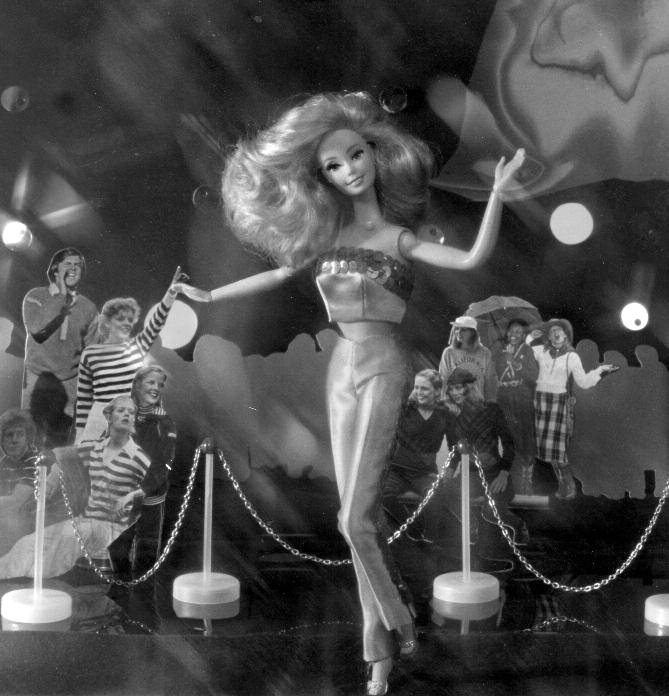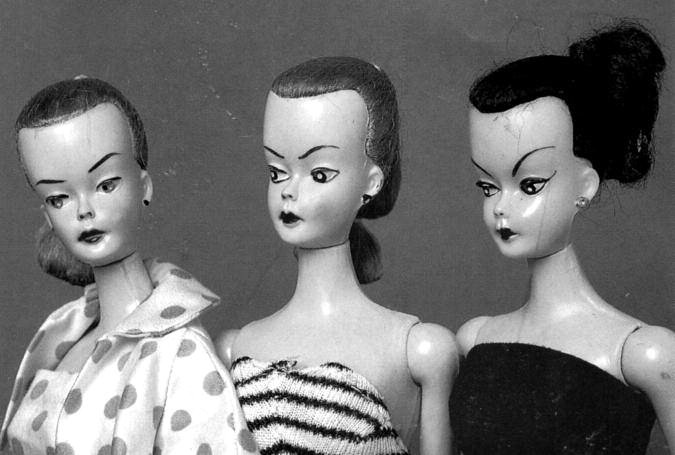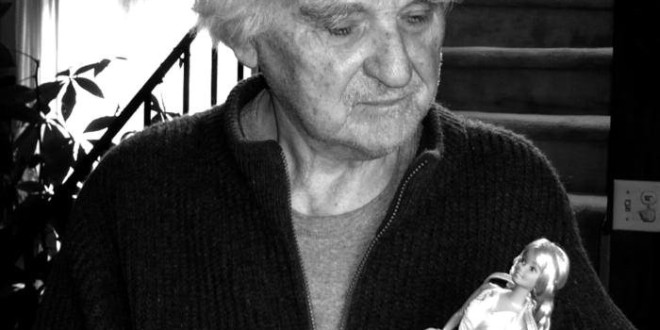Lithuanian American Sculptor and Artist Jurgis Šapkus
BY RAIMUNDAS MARIUS LAPAS.
Meet the legend that so many of us grew up with in the 60s and 70s. Her full name is Barbie Millicent Roberts. Her height was 11.5 inches. She made her debut in 1959 at the International Toy Convention with a wardrobe of 20 different outfits. She dazzled young girls with her strapless bathing suit, sun glasses, high heels and ring-shaped golden earrings. She wore a ponytail with bangs. Her “parents” were Californians Elliot and Ruth Handler – the creators and owners of the Mattel toy dynasty.

Barbie soon made it to the shelves of countless stores throughout the nation and over the decades became an icon of America, coveted by little girls the world over. Part of her fame can be attributed to Lithuanian American sculptor and artist Jurgis Šapkus, who worked for Mattel as a model maker from 1962-1982.
Jurgis Šapkus was born in Panevėžys, Lithuania, on April 24, 1928. He grew up in Kaunas. During World War II he fled Lithuania along with his parents and settled in Augustdorf, Germany. Young Jurgis had very strong artistic inclinations. He enrolled in School of Applied Arts in Freiburg (Ecole des Arts et Métiers) whose director was the celebrated artist Vytautas Kazimieras Jonynas. Šapkus studied graphics. In 1951 he moved to Munich, where he enrolled at the Art Academy (Akademie der Bildenden Künste).
In 1952 Šapkus came to the United States as a displaced person. He settled in Chicago, which was then considered the capital of the Lithuanian diaspora. Like many artists who escaped Lithuania during the war, he found employment in a stained-glass studio. During 1954-1958 he also studied painting and sculpture at the Art Institute of Chicago. Recommended by artist Adolfas Valeška, Šapkus received a number of commissions in Chicago churches; he created a nine-foot sculpture of the “Sorrowful Christ” (Lith.: Rūpintojėlis) and two six-foot figures of Saints Florian and Izidor which were placed above the portal of Holy Cross Church. This church was built by Lithuanian immigrants 100 years ago in the Back of the Yards neighborhood in Chicago and contains the works of several noted Lithuanian artists. Šapkus also produced a series of sculpted wire figures and stained glass murals for the Chicago Savings and Loan Association, and a 24-foot “Gemini” fountain of cast stone for St. Mary’s Hospital in Apple Valley, California.
While working with stained glass, he designed and executed a complete set of windows for St. Donatus Church in Elmhurst, Illinois; two altar windows for the Polish National Church in Chicago, and windows for various churches and temples in the Chicago area.
In 1962 a friend told Šapkus of a job offering posted in a local newspaper. Soon Šapkus was moving to Los Angeles to work as a designer and production manager at the leading toy maker in the United States, Mattel. He was responsible for the development of one of the foremost dolls in the toy industry, the Barbie doll, and became the possessor of some 16 toy mechanism patents as well.
I conversed with Jurgis Šapkus about his years at Mattel.
“Jurgis, you devoted 20 of your most productive years to the toy industry. How difficult was it to find your proper place in this haven?”
I lived in Chicago. A friend of mine showed me a newspaper ad with a job opening at Mattel. I sent out some sample drawings. Apparently they were impressed enough to send a company rep from the West Coast to personally see me. In no time I found myself with a new job and packing up my furniture and belongings and moving to the other end of the United States. That was in 1962. Actually, I worked as a sculptor at Mattel for only one year. Later, I was asked to design mechanisms for toys – primarily for dolls. It was a pleasure working with my team – they were easy-going and fun to be with. My boss Tim Louis was a gifted sculptor, the president of Mattel, Elliot Handler, was a gifted painter. Elliot’s brother Al worked as a sculptor while his wife Neda was also a painter. I myself was directly working with talented sculptors from England, Italy and Mexico. The Handlers were extremely demanding, never accepting second rate work.
My boss gave me a separate office and I was even assigned a technician to assist with mechanism problems. I also had access to the technical workshop. The job was interesting, but unfortunately, not in my creative sphere as a painter or sculptor.
What was your first assignment at Mattel?
To create wax samples of Barbie.
So Mattel was impressed by your sculptures?
Nah, not at all! (Šapkus laughs.) They were only concerned with their own ideas and projects and had no need for my sculpture.
Barbie was born in 1959. You showed up at Mattel three years later. What type of a Barbie did you find upon your arrival?
Back then she was extremely simple. Just look at the old pictures and the first production lines. Barbiehas come a long, long way in all those years.

If I remember correctly, Barbie was the “brainchild” and creation of Ruth Handler?
The company president was no stranger to me. She told me of how Barbie came about. It was Ruth’s 40th birthday and she along with her husband Elliot, 15 year old daughter Barbara and 12 year old Ken were on a six week tour of Europe. They were in Lucerne, Switzerland where the were transfixed by window of a toy store. The couple had already been creating its Mattel dynasty for twelve years, producing some of the hottest toys in America. They could not get their eyes off of six 11-inch tall adult-style female dolls, all with identical faces and hair but each wearing a different European ski outfit. In those days, Europeans dressed much differently from Americans and these ski outfits – far from the flashy but functional ski wear you’d see in the States – looked more like costumes to American eyes. Barbara, who was nicknamed Barbie by her parents, was enchanted by these Swiss skiers. Though she had long stopped playing with dolls, she still liked to collect them.
Ruth had admitted to me that that the “Lilli” doll was the embodiment of an idea she had pitched to her husband and her other Mattel toy designers some five years earlier. Not her face, mind you. Lilli was based on a character in a cartoon strip that appeared in a German newspaper called “Bild” and had become popular throughout central Europe. Ruth thought Lilli’s face was too hard-looking and cartoonish. But Lilli’s body was another story. Her bust, small waist, long, tapered legs was what Mrs. Handler so enthusiastically described to her designers all those years ago. Upon the Handlers return from Europe, Ruth took the Lilli doll to Jack Ryan, head of the research and design department. Jack was about to leave on another toy assignment in Japan, and Ruth asked if he could find a manufacturer there to produce a doll of same size. Three years later Barbie debuted at the Toy fair in the Big Apple.
Barbie’s friendship with Midge did not last very long – a mere three years
… Keep in mind that it was strictly marketing to see how long Midge will last. Remember, it’s the consumer who dictates what is manufactured – the girls who play with the dolls and the moms who buy them (or not…).
How has Barbie changed in the last five decades?
She is manufactured far better now. Her colors are better, materials used are softer. Even Barbie’s face is far more attractive. It’s the result of improved and refined technical production.

Jurgis, you have registered in Washington, D.C. sixteen toy mechanism patents?
For some reason they were labeled them as inventions, although in reality they were never really complex. The main point is that they can be relatively easy to execute and that parents be skewed to the product. They see it on TV – and bingo, they go out and buy it. And then, junior turns around with it for a day or two and tosses it into the corner never to be played with again. Don’t underestimate a kid – after all, he, too, has his own imagination!
I’m guessing your daughter had a Barbie doll. While growing up did she realize that her father contributed to the creation of this doll?
Yes she did, but she never cared for dolls, or for that matter toys in general. She preferred pets. Most girls like to play with dolls, but not my daughter…
Were there times you wanted to change Barbie’s image, but were signaled the red light?
If changes were ever to be made, it was not my responsibility, but solely the choice of the marketing manager.
However, there was that personal inclination to change Barbie’s image?
Let’s not kid ourselves Raimundas! Sure I did! But it would not have been cost effective. My interest was that Barbie would “come alive” with total movement – not merely her head, but her whole body…
How do you predict Barbie’s future?
Its a miracle that she’s still around after well over half a century. Rarely does a toy have such a life expectancy. But lets be frank – little girls want to grow up and be like Barbie. That is what continuously guaranties her popularity. Mattel made an extremely shrewd marketing venture.
When I asked Jurgis how he foresees the toy industry, he responded: “Girls will remain girls and dolls will always exist!”
 DRAUGAS NEWS Lithuanian World Wide News in English
DRAUGAS NEWS Lithuanian World Wide News in English
